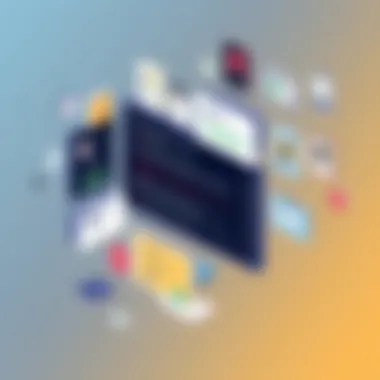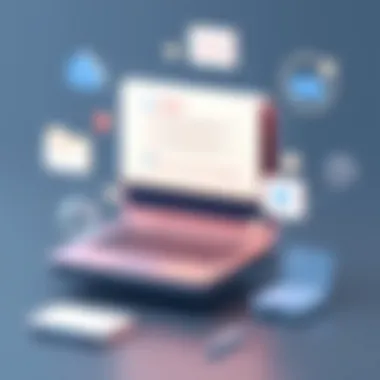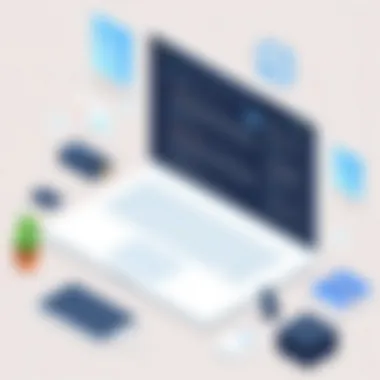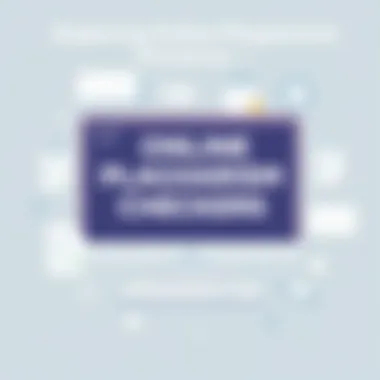Exploring Online Plagiarism Checkers: Tools and Techniques


Intro
In the digital age, where information flows like water, the integrity of content is paramount. Writers, academics, and professionals alike are tasked with ensuring that the originality of their work is maintained. And this is where online plagiarism checkers step into the spotlight. They serve as both gatekeepers and guides, helping users navigate the murky waters of content authenticity.
Plagiarism not only jeopardizes one’s credibility, but it can also lead to severe academic and legal repercussions. By using these tools, individuals can effectively avoid pitfalls and produce content that is not only unique but also reflective of their own voice and ideas. This article will dive into the functionalities of various plagiarism detection tools, examining their strengths and weaknesses, while also presenting best practices to maximize their utility. Whether you're a student preparing an essay, an author crafting a manuscript, or a professional ensuring the quality of your content, this guide aims to equip you with the knowledge necessary to uphold integrity in your writing.
As we embark on this exploration, we'll break down the features that make these tools invaluable, discuss how they operate, and look into various options available today. Prepare to uncover the mechanisms that uphold the sanctity of content creation in our fast-paced digital world.
Understanding Plagiarism
Plagiarism isn't just a mere academic concern; it's a broader issue that can tarnish reputations and undermine trust in various fields, including literature, journalism, and research. Understanding plagiarism is crucial for anyone who crafts written content, whether for academic purposes or creative expression. Knowing what constitutes plagiarism aids individuals in cultivating originality and creativity in their work. More than just avoiding copying someone else's writing, it’s about grasping the principles of intellectual property and the value of ownership in a crowded digital space.
Definition of Plagiarism
At its core, plagiarism can be defined as the act of presenting someone else's ideas, words, or creations as one’s own without proper attribution. This applies not only to direct copying of text but also to paraphrasing someone's unique conceptual framework or using their ideas without acknowledgment. It's essentially intellectual theft, which has serious ethical implications. The act can take many forms—from swapping out a few words in someone else's paper to outright copying various sections verbatim without citation. Hence, understanding plagiarism starts with a clear and distinct identification of what copying means across different contexts.
Types of Plagiarism
Plagiarism comes in several forms, each with its own characteristics and implications. Here are some commonly recognized types:
Direct Plagiarism
Direct plagiarism involves copying text word-for-word from a source without giving due credit. This is the most clear-cut form of plagiarism and is often considered the most serious. Why is it so significant? Well, it undermines the whole notion of authorship and can lead to severe consequences—a student might fail a course, or a professional might lose their job. It’s a big no-no in the academic world and has no gray areas; if it’s not your creation, credit the rightful creator.
Self-Plagiarism
Self-plagiarism refers to the practice where individuals reuse their previous work without acknowledging that it has been used before. This is a bit tricky because it’s not about taking someone else's work but rather your own. However, in academic and professional fields, this can still lead to issues, particularly if prior works have been submitted for credit or publication. In essence, thinking of your past work as fair game without citation doesn't align with the strict standards of originality.
Ghost Writing
Ghost writing occurs when someone writes content that is officially credited to another person. It's popular among authors and politicians, but it can stir up controversy if the ghostwritten content is thought to misrepresent the original creator's voice or intent. While it can be seen as a collaborative effort, it raises ethical questions about ownership and authenticity. The key characteristic of ghost writing is that the ghostwriter is usually not recognized as an author, leading to potential debates about the morality of such agreements.
Consequences of Plagiarism
The repercussions of plagiarism extend beyond academic penalties; they can damage a person's career and credibility. Individuals found guilty face disciplinary actions from institutions, ranging from failing grades to expulsion. In professional circles, the consequences can be even more severe, leading to lawsuits and damage to one's reputation. Therefore, understanding plagiarism is not just about avoiding penalties but also about fostering a culture of integrity in writing.
"Plagiarism not only affects the one who commits it, but it can also shake the very foundations of trust in academia and beyond."
Why Use Plagiarism Detection Tools?
In today’s digital era, where information is at our fingertips, the need for originality in writing cannot be overstated. That's where plagiarism detection tools come into play. These tools are indispensable for students, educators, and content creators alike, as they serve to uphold the standards of academic integrity and foster creativity. Let's explore two significant aspects of why using these tools is not just advisable—it’s essential.
Ensuring Academic Integrity
The phrase "academic integrity" boggles the mind with its importance. In educational environments, whether it’s a bustling university or a remote online class, honesty is the bedrock of learning. Plagiarism isn’t merely about copying someone else’s work; it’s about undermining the very process of education. When students submit work that isn’t their own, they deprive themselves of the learning experience.
Utilizing plagiarism detection tools acts like having a trusty compass in unknown territory. It can help students and educators ensure that assignments reflect true understanding and effort. Many universities have strict policies against cheating, and employing a plagiarism checker can serve as a preemptive strike against slipping into academic misconduct. If a student’s paper gets flagged, they can address and correct the identified sections, thereby ensuring their final submission doesn’t just meet the requirements but also exhibits their unique voice.
Moreover, there’s an ethical dimension to using plagiarism checkers; it shows a commitment to fair play in the educational landscape. This tool helps teachers identify potential plagiarism in students’ work, enabling them to provide constructive feedback and additional support where necessary.


Enhancing Content Originality
Originality is the hallmark of innovation. In the realm of writing, whether for blogs, research articles, or marketing content, standing out is crucial. By utilizing plagiarism detection tools, writers can significantly enhance the originality of their content. But it’s not just about avoiding the red flags; it’s about cultivating unique perspectives.
Here’s where it gets interesting. Many writers might believe that what they’ve penned is entirely their own words, yet there can be strains of similarity with existing works—especially in niche areas. By examining their writing through the lens of a plagiarism checker, creators can refine their content, ensuring it brings something fresh to the table. It promotes an enriching experience, not just for the writer but for the end readers who seek novel insights.
Furthermore, many of these tools not only highlight areas of potential plagiarism but also offer suggestions for modification, making it easier for writers to pivot and craft something original. It’s like having a personal editor whose sole aim is to keep your work authentic and engaging.
Popular Plagiarism Checkers Online
In an age where information flows faster than a river in spring thaw, keeping content original has never been more crucial. Popular plagiarism checkers serve as a safety net, ensuring that the words we write remain genuinely ours. This section dives into the realm of these tools, elaborating on their significance, their features, and how to wisely pick one that fits your needs.
Overview of Available Tools
With an ever-growing list of plagiarism checkers popping up online, there’s no lack of options for users. The selection ranges from well-established giants to emerging players, each boasting unique features that tackle the formidable task of detecting copied content. Prominent tools like Turnitin, Grammarly, and Copyscape stand out due to their widespread recognition and reliability. Here are a few notable features to consider:
- Database Size: Some tools check against vast repositories of academic work, publications, and websites, while others might focus solely on web content.
- User Interface: Ease of use varies greatly. An intuitive interface can save time and effort during the scanning process.
- Real-time Scanning: Features such as live scanning display results as you type, ensuring seamless integration into your writing process.
- Customization Options: Some tools allow users to set specific parameters for scans, tailoring the search to particular needs.
Given the varying capabilities of each tool, having the right one can make a world of difference in maintaining authenticity.
Free versus Paid Tools
A natural question arises when exploring plagiarism checkers: should you opt for a free version or invest in a paid tool? The answer isn’t cut and dry but hinges on your specific needs.
Free Tools
Free plagiarism tools can be quite tempting, particularly for casual users or students watching their wallets. They generally offer basic functionalities, covering common checks. Examples include:
- Plagscan: Limited checks but quite effective for small documents.
- DupliChecker: Great for quick scans, though not as comprehensive.
However, it is essential to note that many free tools may have restrictions such as:
- Limited word count per scan.
- Basic report details.
- Less frequent updates to their databases.
Paid Tools
On the other hand, investing in a paid tool can unlock a treasure trove of features. Take, for example, Grammarly’s premium version which not only checks for plagiarism but also enhances grammar and style. Pros of choosing a paid service include:
- In-depth analysis and reporting.
- Access to an extensive database for comparison.
- Higher accuracy rates and detailed insights.
But, of course, with great power comes great responsibility—and expense. A well-placed investment in a robust plagiarism checker can save time and effort in the long run, especially for writers who consistently crank out content.
Analyzing Specific Plagiarism Checkers
When discussing plagiarism checkers, it's crucial to dive deeper into specific tools that dominate the market. Analyzing these tools provides insights into their effectiveness, functions, and suitability based on different user needs. Each checker has its unique capabilities and limitations. By exploring individual checkers, users can assess which tool aligns best with their purposes. This evaluation not only aids in selecting the right software but also fosters a broader understanding of how these platforms uphold originality in content creation.
Turnitin
Features
Turnitin is renowned, especially in educational circles, for its extensive database and unique features. Its primary function revolves around comparing submitted text against a myriad of sources, including student papers, academic publications, and content available on the internet. One key characteristic of Turnitin is its ability to provide detailed similarity reports, highlighting areas of potential plagiarism. This specificity allows users to pinpoint exact phrases and where they appear in existing works.
A unique addition to Turnitin is its peer review functionality. This feature permits students and educators to review each other's work, enhancing the learning process. In terms of benefits, this tool is considered a robust choice for academic institutions due to its thoroughness and credibility. However, its reliance on institutional subscriptions may limit access for individual users.


Limitations
Despite its strengths, Turnitin has certain limitations. One major drawback is its cost; it’s primarily available through institutional licenses, which makes it inaccessible for casual users or freelancers. Furthermore, Turnitin’s database is less exhaustive when it comes to non-academic content. This means some web-based sources may not be included in its checks, potentially leading to misleading results. Additionally, the system’s interface can also feel somewhat complex for new users, requiring a learning curve to navigate efficiently.
Grammarly
Features
Grammarly extends beyond mere grammar correction; it offers a plagiarism checker that scans texts against billions of web pages. A standout aspect of Grammarly’s feature set is its user-friendly interface that integrates seamlessly with writing platforms like Microsoft Word and Google Docs. This capability allows users to check for plagiarism without switching between tools, which is convenient for writers engaged in seamless content creation.
Moreover, Grammarly’s real-time feedback is beneficial, providing immediate suggestions for improving overall writing quality. Its ability to catch tone and style issues enhances the overall output, making it more than just a plagiarism tool. Many users appreciate this holistic approach, particularly in professional or business contexts.
Limitations
However, Grammarly's plagiarism checking function may not be as thorough compared to specialized tools like Turnitin. While it does cover a broad internet base, the depth of its database is a subject of debate. Some users have reported instances where notable sources were missed, which could lead to oversight in academic settings. Furthermore, while Grammarly has a free version, the full capabilities, including the plagiarism tool, are reserved for premium subscribers, limiting casual users who might want to test its features.
Copyscape
Features
Copyscape is tailored specifically for detecting plagiarism on the web, making it a favorite among web content creators. One highlight of Copyscape is its ability to check not only for direct copying but also for near matches and paraphrasing. This nuanced approach allows users to identify borrowed ideas that don’t match verbatim but still lack originality. Copyscape’s ‘Copysentry’ feature also monitors the web for new instances of content duplication, providing added peace of mind for website owners.
This tool shines in its simplicity and effectiveness, especially for those focused on maintaining the originality of online content. Its interface is straightforward, allowing users to copy and paste text easily, making it accessible to less tech-savvy individuals as well.
Limitations
Yet, Copyscape is not without its faults. A significant limitation is its focus mainly on online content; documents that aren’t published on the internet will not be checked. This can be a disadvantage for academic settings or those dealing with offline material. Additionally, while it offers free checks for shorter texts, users have to pay for premium scans, which could add up for frequent users.
Quetext
Features
Quetext distinguishes itself with a design that emphasizes ease of use. Its deep search technology offers users a thorough scan of the web for potential sources of plagiarism. A particularly engaging feature is its color-coded feedback, which helps users quickly identify issues. The clearer this feedback is, the easier it is for writers to make adjustments, making Quetext an appealing choice for novices and experienced creators alike.
Another significant aspect of Quetext is its focus on contextual analysis. This means it doesn't just point out similarities but also assesses how phrases and ideas are used in context, offering more insight into originality.
Limitations
Despite its attractive features, Quetext does have restrictions. For one, while it’s user-friendly, its scope may not be as extensive as other top-tier tools like Turnitin or Grammarly. Users in need of comprehensive academic reporting might find Quetext lacking in that department. Additionally, higher-tier features require a subscription, which can limit its accessibility for casual users or those on a budget.
Each plagiarism checker brings its unique strengths and limitations to the table. Users should weigh these aspects carefully based on their specific needs and contexts, ensuring they choose a tool that not only meets their standards of effectiveness but also fits within their budget considerations.
Evaluating Plagiarism Checker Effectiveness
To navigate the digital landscape of content creation today, it has become paramount to ensure that original ideas and crafted pieces are not tainted by inadvertent plagiarism. Understanding the effectiveness of plagiarism checkers plays a pivotal role in this process. These tools are designed to help users pinpoint the authenticity of their written work, which is particularly important in academic settings, professional industries, and even personal projects. The accuracy and reliability of these tools can vary significantly; thus, dissecting their effectiveness is not just beneficial but necessary for anyone keen on protecting their intellectual contributions.
Accuracy Rates
When we discuss accuracy rates, it’s essential to understand what metrics define the performance of plagiarism detection tools. In this context, accuracy refers to how well a checker can identify plagiarized content against a backdrop of originality. Tools that boast high accuracy rates generally evaluate vast databases of sourced material, including academic journals, web pages, and proprietary content.


Managing high accuracy means that these services can accurately detect similarities and potential plagiarism, thus saving writers from pitfalls that can lead to academic penalties or damaged reputations. Consider the following points:
- Database Coverage: The broader the database, the higher the likelihood that a plagiarism checker can compare your text against numerous sources.
- Algorithm Efficacy: Sophisticated algorithms often incorporate machine learning techniques. This means they can adapt and improve over time, boosting precision in detection.
- Misidentified Content: A challenge remains that some checkers might flag correctly cited materials as plagiarized. Hence, evaluating their accuracy also involves assessing their knack for distinguishing between original writing and cited sources.
Comparison of Results
The comparison of results from various plagiarism checkers can provide insight into their relative effectiveness. Users may find discrepancies between them due to factors like differing methodologies or how they interpret data. This aspect of evaluation is particularly critical when making a choice about which tool to utilize. Here are a few considerations:
- Cross-Checking: Utilize multiple tools when in doubt. Running the same document through various platforms can highlight inconsistencies and provide a clearer picture of potential issues.
- Feedback Mechanism: Some tools offer suggestions or adjustments based on flagged content, which could help the user rectify issues before submission or publication.
- User Experiences: Relying on peer reviews or testimonials can assist in gauging the general reliability of a plagiarism checker. Platforms like Reddit or specialized educational forums can serve as repositories of real user feedback.
"Plagiarism detection is as much an art as it is a science; it requires constant tuning of algorithms to adapt to ever-evolving writing styles and sources."
In essence, evaluating plagiarism checker effectiveness hinges on careful consideration of accuracy rates and a thorough comparison of results across varying tools. By engaging with these factors critically, you can make informed decisions that not only safeguard your original content but also uphold the standards expected in academic and professional writing.
For further examination of plagiarism checkers and their effectiveness, consider visiting Wikipedia on Plagiarism, which offers a comprehensive insight into the topic.
Best Practices for Using Plagiarism Checkers
Using plagiarism checkers can feel like having a safety net, especially in the delicate world of content creation and academic writing. Not only do these tools help ensure the originality of your work, but they also bolster your credibility and integrity. However, to get the most out of these resources, it's vital to follow certain best practices.
How to Interpret Results
Interpreting the output from plagiarism checkers isn’t always straightforward. After running your text through a tool, you often receive a report highlighting various sections flagged for potential plagiarism. This is where discerning users can glean true value.
- Understand the percentage: Tools typically indicate the percentage of your work that matches other sources. A lower score means more originality, while higher percentages hoist a red flag.
- Review the sources: Plagiarism checkers provide links to the content they match. It’s crucial to review these sources. Is it common knowledge? Has it been quoted correctly? Recognizing the context helps differentiate between legitimate concerns and false positives.
- Make required adjustments: If legitimate matches appear, it’s time for revision. Paraphrase, quote appropriately, or cite correctly to mitigate issues and enhance originality. Developing this habit not only improves single documents but also aids in honing your writing skills over time.
Common Misunderstandings
Many users often fall prey to misconceptions surrounding plagiarism detection. These misunderstandings can lead to unnecessary panic or complacency, undermining the purpose of utilizing these tools.
- Assuming a perfect score means no plagiarism: It's essential to recognize that even a spotless report doesn’t mean your work is entirely original. The tool might not have access to all sources, especially databases or proprietary content.
- Believing paraphrasing eliminates plagiarism: Simply rewording sentences doesn't guarantee originality. This approach may often haven’t sidestepped plagiarism entirely. Proper citations and temperate quotation practices should still be observed.
- Using only one tool: Relying solely on one plagiarism checker is another common misstep. Different tools utilize varying algorithms and databases, leading to discrepancies. Running your text through multiple services increases accuracy, giving you a more comprehensive understanding of your work's integrity.
In summary, navigating the quirks of plagiarism detection requires an informed approach. Paying attention to the interpretations of results and recognizing misconceptions can lead to a more scrupulous and effective use of plagiarism checkers. This not only elevates your work's authenticity but also may empower your writing endeavors in the long run.
The Future of Plagiarism Detection
As we tread deeper into the digital era, the future of plagiarism detection is not just relevant; it is essential for maintaining the integrity of academic and creative work. With an ever-expanding sea of information available online, the need for sophisticated tools that can accurately identify instances of plagiarism has become paramount. This section delves into what lies ahead in this domain, focusing on emerging technologies and potential improvements that could reshape the landscape of plagiarism detection.
Emerging Technologies
The evolution of plagiarism checkers is increasingly being shaped by cutting-edge technologies. Here are some key developments that are making waves in the field:
- Artificial Intelligence & Machine Learning: Advanced algorithms are being developed that allow plagiarism checkers to learn from vast datasets. This enhances their capacity to understand context and detect nuanced cases of plagiarism that traditional methods might miss.
- Natural Language Processing (NLP): By harnessing NLP, future plagiarism detection tools will not just rely on exact matches but will also analyze the semantics of writing. This treatment could help identify paraphrased content or ideas that are expressed differently yet still borrow heavily from original works.
- Blockchain Technology: Imagine a decentralized system where original works can be verified through blockchain. This could prevent unauthorized use and provide a clear trail of authorship, ensuring that the rights of original creators are upheld.
Plagiarism detection is moving from simple matching algorithms to more sophisticated systems that understand context and authorship—this will revolutionize how we view originality.
- Cloud Computing: The integration of cloud technology means that plagiarism checkers can offer real-time analysis and store vast amounts of data securely. This facilitates faster processing and allows tools to reference larger databases for accurate results.
These technologies, as they advance, will enhance the effectiveness of plagiarism detection tools, making them easier to use and more reliable for all users.
Potential Improvements
While existing plagiarism checkers serve their purpose, they are not without limitations. Looking ahead, several potential improvements could dramatically enhance their functionality:
- User-Friendly Interfaces: Simplified dashboards with intuitive designs will make the tools accessible to a broader audience, including those who may not be technically savvy.
- Customization Options: Users will likely benefit from more customizable settings that allow them to tailor detection criteria based on their specific needs. For instance, researchers can adjust the strictness of matches when dealing with common terminologies in certain fields.
- Multi-Format Support: Future plagiarism tools should seamlessly support various formats, from academic papers to online content, ensuring that they can cater to different types of writing.
- Integration Capabilities: The ability to integrate with popular writing platforms or citation tools (like Zotero or EndNote) is crucial. This would streamline the workflow for users and ensure they can verify originality without needing to switch applications constantly.
- Collaboration Features: As remote work becomes more rooted in our daily lives, tools that enable collaborative checks for teams can save time and ensure that all members adhere to standards of originality.
These areas of potential improvement indicate that the future of plagiarism detection will not just center on finding similarities but creating a holistic ecosystem that supports and enhances the user's writing journey.



